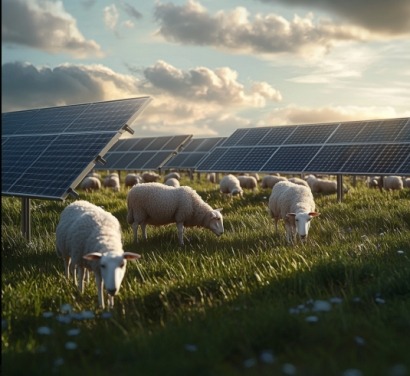
Modern farms are tapping into a powerful combination of artificial intelligence, automation and renewable energy. By doing that, they’re creating agricultural systems that feed and help heal the world.
The marriage between cutting-edge technology and traditional farming creates fresh opportunities for environmental stewardship. By combining artificial intelligence and agriculture, for example, farmers can make more precise decisions while using fewer resources.
The use of artificial intelligence in agriculture is revolutionizing how people grow food. AI-powered systems can analyze vast amounts of data from soil sensors, weather stations and satellite imagery to provide farmers with actionable insights. These systems can predict optimal planting times, detect plant diseases before they spread and precisely determine irrigation needs.
A study published in the journal energy found that AI-driven precision agriculture can increase crop yield by 15% to 20% while significantly reducing the overall investment required. This decreases the environmental impact and lowers production costs for farmers.
The benefits extend beyond resource conservation. AI systems can monitor livestock health, track their behavior patterns and optimize feeding schedules so farmers can detect health issues earlier.
Automation and agriculture are addressing two critical challenges — labor shortages and environmental impact. Autonomous tractors, drones and robotic harvesters are becoming increasingly common on modern farms, performing routine tasks with a high level of precision. Automated equipment can follow exact paths to minimize soil compaction, apply fertilizers only where necessary and harvest crops at peak ripeness.
The integration of renewable energy in agriculture represents perhaps the most significant shift toward sustainability in the sector.
Solar energy and agriculture are proving to be natural partners. Farmers are installing solar panels on barn roofs, over irrigation channels and even integrating them into field layouts through innovative agrovoltaic systems, diversifying revenue while improving crop resilience.
Agrovoltaics — which is the practice of co-developing land for solar power and agriculture — shows particular promise. Certain crops perform better under the partial shade of solar panels, especially in regions experiencing increasing heat stress due to climate change.
Wind turbines are becoming increasingly common sights on farmland across the country. For farmers with suitable land, this electricity is environmentally friendly and generates an extra income source through leasing agreements with power companies. Alongside solar installations, a single modern wind turbine can reduce carbon dioxide emissions annually compared to fossil fuel electricity generation.
Agriculture and renewable energy find perfect synergy in bioenergy. It comes from agricultural waste — from corn stover to animal manure — and can be converted into biogas or biofuels, creating a circular economy model on the farm. Anaerobic digesters that process animal waste into biogas provide multiple benefits — they reduce methane emissions, create renewable energy, reduce nutrient run-off to protect waterways and more.
Integrating alternative energy in agriculture can present an early challenge the results quickly counter. While individual technologies offer significant benefits, the true power of sustainable agriculture comes from creating systems where artificial intelligence, automation and renewable energy work in concert.
Data-driven sustainability is the foundation of these integrated systems. AI-powered platforms can analyze information from multiple sources to optimize entire farming operations.
They could automatically adjust irrigation systems by reading weather forecasts and soil moisture data. Meanwhile, energy management systems can schedule power-intensive activities during peak renewable production times. For example, considering electric mowers handle better and are lighter than their fossil-fuel-powered counterparts, keeping them charged for daily tasks is a must. Timing the charge so it relies exclusively on renewable power makes the process more eco-conscious.
AI-driven agriculture monitoring can reduce water overuse through precise application timing and volume adjustments. This precision represents a critical benefit, as climate change exacerbates water scarcity in many agricultural regions.
Despite the clear benefits, several challenges hinder the widespread adoption of sustainable agriculture technology:
Government incentives, educational programs and innovative financing models are helping address these barriers. Some organizations provide grants specifically targeted at renewable energy and efficiency improvements on farms, making these technologies more accessible to small and medium-sized operations.
Agriculture is responsible for a significant amount of U.S. greenhouse gas emissions. By integrating renewable energy sources and optimizing operations with AI and automation, farms can reduce their carbon footprints. Renewable energy integration can transform farms from carbon sources to carbon sinks, actively removing carbon dioxide from the atmosphere.
Traditional agriculture can come at the expense of biodiversity. However, technology enables sustainable practices that are helping reverse this trend.
AI systems can identify areas within farmland that would benefit from being converted into wildlife habitats with minimal impact on productivity. Precision application of pesticides means less harmful chemicals reaching non-target species, and automated equipment can navigate around environmentally sensitive areas.
The path toward agriculture processes that are truly sustainable requires continued innovation and adaptation. Several emerging trends will likely shape the future of farming.
Regenerative agriculture — the farming practices that rebuild soil and restore its biodiversity — is being enhanced by technology. AI systems are helping farmers track soil health indicators and make management decisions that actively improve sustainability over time.
Beyond solar wind and bioenergy, alternative energy sources like geothermal and small-scale hydroelectric are finding applications in agriculture. These diverse renewable energy options help ensure farms in any geographic location can reduce their fossil fuel dependence.
The challenges facing the global food system are immense, but the convergence of artificial intelligence in agriculture, automation and renewable energy offers a path forward. By embracing these technologies, farmers can produce the food people need while protecting the planet everyone depends on.
The farms of tomorrow will be more than food production facilities. They will be sophisticated, technology-enabled ecosystems that generate renewable energy, sequester carbon, support biodiversity and efficiently produce nutritious food with minimal environmental impact.
For agricultural professionals, the message is clear — sustainable farming processes powered by AI and renewable energy are an economic opportunity. The farms that thrive in the coming decades will be those that successfully integrate these technologies into systems that benefit both bottom lines and the planet.
As consumers, supporting farmers who invest in these sustainable technologies ensures agriculture can continue to feed the world while helping heal it. The sustainable agriculture revolution is already underway, and its successes will depend on the industry’s choices today.

